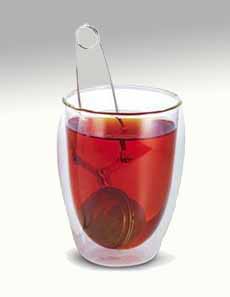PRODUCT: Rooibos Chai Tea, No Caffeine
|
Lovers of spicy chai tea have an alternative to black tea. This chai from Fave Tea is made with a base of rooibos (red tea), an herbal tea that’s naturally caffeine-free (photo #1). Now, chai fans who don’t want caffeine free can enjoy it day or night. While most herbal teas don’t mix well with milk or cream, rooibos chai takes either, very well. If you like sweetened tea, add your sweetener of choice. It will enhance the cardamom and peppercorn notes of the chai. What is chai? Chai tea is an erroneous American term for what should be called masala chai. In Hindi, chai is the generic* word for tea; masala means spiced. In other words, it’s spiced tea. What is rooibos? Pronounced ROY-boss, rooibos is a bush that grows in South Africa. The name means red bush in the Afrikaans† language; the leaves steep into a red-colored brew (photo #2). Honeybush is a cousin to rooibos, also cultivated in South Africa. It is similar in flavor (slightly sweeter with a fuller body) but its flowers have the aroma of honey; hence the name. Rooibos is very healthy: no caffeine, high levels of antioxidants and low levels of tannin. Children—even infants—can drink it. Ready to drink some? |
|
|
|
________________ *Traditional chai is a strong black Indian tea infused with milk, sugar, and spices—commonly cardamom, cinnamon, ginger, peppercorn, clove and nutmeg (chocolate or licorice also can be used). In India the beverage is known as masala chai, or spiced tea: Masala is the Hindi word for spice, and chai is the Hindi word for tea. While chai is traditionally made from black tea, green tea chai and rooibos chai have become popular. †CHAI VS. TEA: All related forms of the word chai—Turkish çay, Russian/Persian/Hindi/Urdu chay, etc.—derive from the original Mandarin, cha. Cha became the Cantonese, Mandarin and Japanese word for tea. Other Chinese dialects have different words; e.g. the Wu dialect spoken around Shanghai uses the word zu and the Hokkien dialect spoken around the port of Xiamen in the Fujian province uses the word tay. The word “cha” traveled to the Middle East and Eastern countries, while “tay” traveled to Europe and became our word for tea. Xiamen was the port of trade first used by Europeans (mainly the Portuguese) in 1541. Near the end of the Ming Dynasty, in 1644, British merchants set up trading posts there; in the 19th century, it was China’s main port for exporting tea. As a result, the Hokkien dialect spoken there, not Mandarin which traveled west via overland trade routes, influenced what Europeans called the beverage. What the Xiamenese people call tay, the British spell tea, the French spell thé, the Spanish té, the Italians tè and the Germans, tee. The pronunciation varies from “tay” to “tee.” Other words from the Hokkien language that entered English: ketchup (kiô-chap), Pekoe (pekh-hô), kowtow (khàu-thâu) and Japan (Jit-pún). ‡Afrikaans is a West Germanic language spoken in South Africa and Namibia and, to a lesser extent, in Botswana and Zimbabwe. It began to develop independently in the 18th century, an offshoot of several Dutch dialects spoken by the mainly Dutch settlers of what is now South Africa.
|
||




